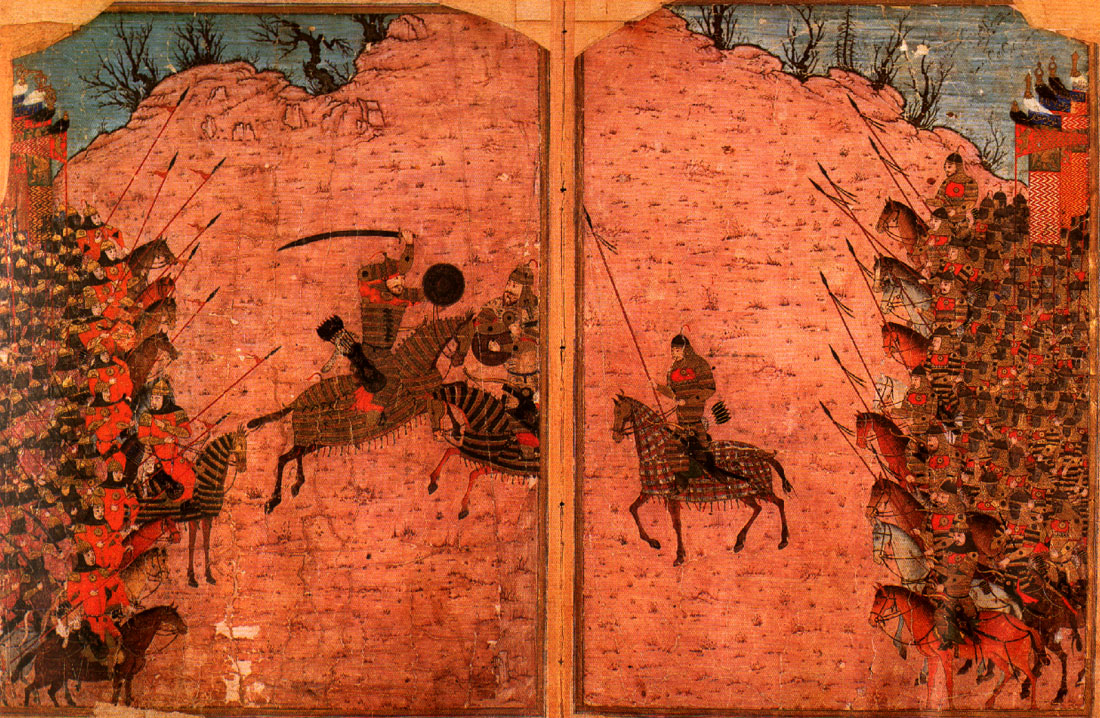|
|
Rustam fights the Mazandarani champion Juya
Illustrations of Jalayrids from a late 14th Century Shahnama
The figures wear contemporary dress or dress of no latter than the date of the illustrations.

Episode from a Battle between the Iranians and the Turanians
Shah-nama.
From the Sarai Albums
Tabriz, second half of 14th century
Hazine 2153, folio 52b-53a
Source: Mongols and Painting under the Jala'ir
Referenced as Plate 46 in: M. GORELIK, "Oriental Armour of the Near and Middle East from the Eighth to the Fifteenth Centuries as Shown in Works of Art", in: Islamic Arms and Armour, ed. ROBERT ELGOOD, London 1979
46 Miniature from Shāh-Nāmeh, Tabriz, c.1370-1380. (Topkapu Saray Museum. Hazine 2153, fol. 52b-53a)
We observe true plate and mail armour for the first time (46), styled as a short waist-length coat, slit in the front, the upper part made of mail with the lower part laminated, and having steel bands attached to several belts or joined together by a mail juncture, rather than the former method of thin belts or laces.
Accession Number: H. 2153
Title of Work: Topkapi Album
Gregorian Date: 15th century (late)
Origin: Tabriz
Patron: Sultan Ya'qub Aq Qoyunlu
Preface: none
Folios extant in ms.: 199
Columns x Rows: 6 x 32
Page Size (h x w): 502 x 338 mm
Ms Type: Album
Source: Shahnama Project
The Battle between Rustam and Juya of Mazandaran (fig. 19).
Rustam returns from Mazandaran, where he had been sent as an emissary, filled with hatred and anger, and tells his people what he saw and heard there.
Kavus, the commander of the army, prepares for the battle in which the two sides meet on a plain.
Juya, the famous champion of the Mazandaran army, challenges someone from the other side to single combat.
Thereupon the two armies engage and the battle lasts for a week.
When Rustam attacked Juya with his spear and pierced his armor, he was changed into a mountain through magic.
This large composition which covers two pages has been pasted in the album after the removal of a strip from the middle.
Thus a narrow section of the painting, including a part of the main figures of the battle, is missing.
The two armies, watching from both sides, constitute a frame for the painting.
Those on the left are dressed in violet-purple clothes except for the front row which is in orange.
The army on the right wears gold armor with red breast plates.
The labelled flags of both parties are seen on the upper sides of the painting.
The ground is pink-beige with tufts of grass in a darker tone.
The horizon, with leafless trees, is very high, and the sky is painted in shaded tones of light-blue.
The fact that the protagonists of the encounter have been placed in the open space in the middle is enough to concentrate all attention on them.
Both armies, by virtue of the artistís arrangement and the great number of their soldiers, add to the wealth of the scene.
The painting is clearly the work of a master in its detail and execution.
The relative calm of the moments preceding Rustamís eruption makes this a painting of great dramatic impact.
Text source: "Four Istanbul Albums and Some Fragments from Fourteenth-Century Shah-Namehs" by Nurhan Atasoy, pp. 19-48 in Ars orientalis; the arts of Islam and the East Vol. 8 (1970)
Back to Illustrations of Jalayrid Mongols
|

